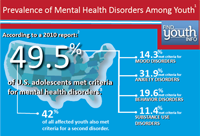New Infographic on Youth Mental Health
Are you interested in learning more about mental health, how mental health affects young people, and what communities can do?

Click to Enlargeyouth.gov Mental Health Youth Topic
Most youth are healthy, physically and emotionally, yet one in every four or five adolescents in the general population meets criteria for a lifetime mental disorder that is associated with severe functional impairment or distress. Visit the youth.gov Mental Health Youth Topic to view the recently developed infographic focused on youth mental health, learn about school-based mental health, and hear from three youth, Cameron, Justin, and Megan who have benefited from school-based mental health services.
MentalHealth.gov
Visit MentalHealth.gov, an online resource for people looking for information about mental health, to learn about the signs of mental illness, how individuals can seek help, and how communities can host conversations about mental health. The website also features videos from a number of individuals who share their stories about mental illness, recovery, and hope.
SAMHSA Toolkit for Community Conversations About Mental Health
Learn how you and your community can start a conversation about mental health and help identify innovative and creative actions to meet the mental health needs of our nation. View SAMHSA’s recently released Toolkit for Community Conversations About Mental Health. The Toolkit has three parts: an Information Brief (also available in Spanish), a Discussion Guide, and a Planning Guide.
CDC Mental Health Surveillance Among Children—United States, 2005–2011 Report
Read the Centers for Disease Control and Prevention (CDC) Mental Health Surveillance Among Children—United States, 2005–2011 report, the first report to describe the number of U.S. children ages 3–17 years who have specific mental disorders by compiling information from different data sources covering the period 2005–2011. It provides information on childhood mental disorders where there is recent or ongoing monitoring. These include ADHD, disruptive behavioral disorders such as oppositional defiant disorder and conduct disorder, autism spectrum disorders, mood and anxiety disorders including depression, substance use disorders, and Tourette syndrome. The report also includes information on a few indicators of mental health, specifically, suicide and estimates of the number of days individuals experienced mental health issues. The report was developed in collaboration with key federal partners—the Substance Abuse and Mental Health Services Administration (SAMHSA), the National Institute of Mental Health (NIMH), and the Health Resources and Services Administration (HRSA). It is an important step toward better understanding these disorders and the impact they have on children. Learn more by visiting the CDC website.
